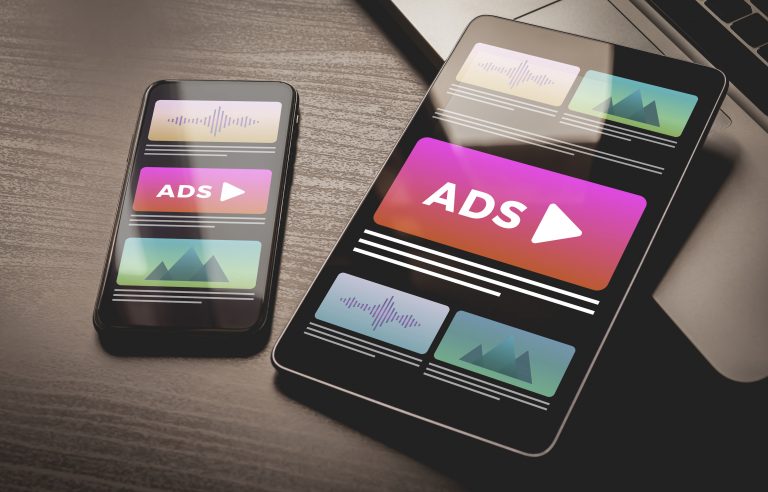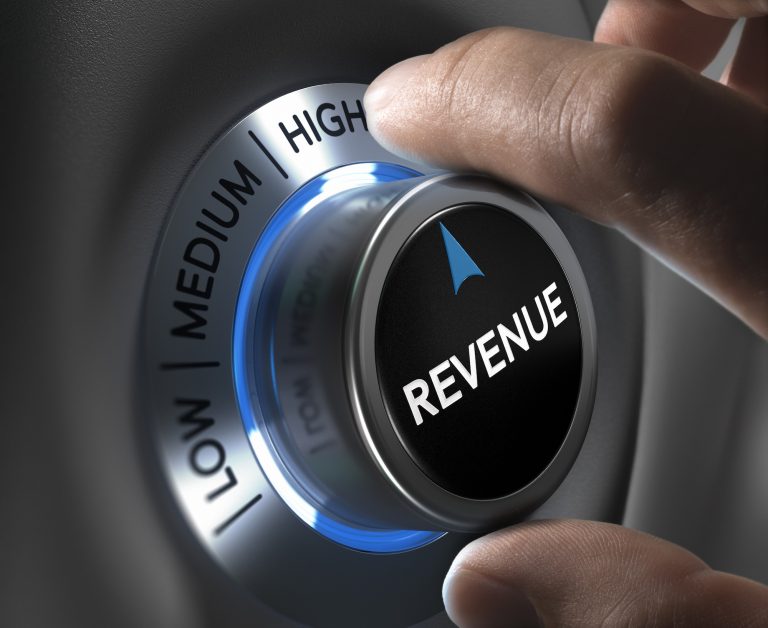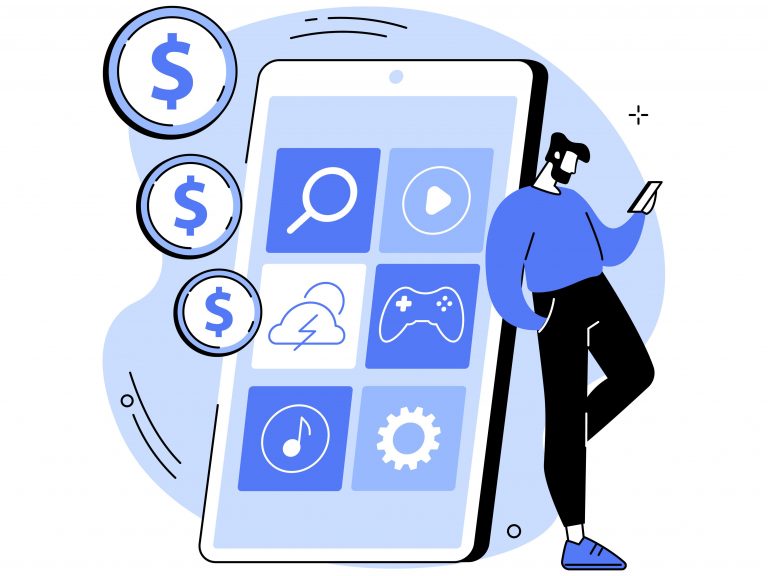It’s undeniable that mobile app monetization is a huge revenue generator for developers and publishers alike. In 2021 alone, Android and iOS app revenue topped $133 billion, reaching an increase of 19% from 2020. The highest generating category was gaming apps, which made up more than two-thirds of all revenue. For 2022, total revenue forecasts are projected at $437.8 billion globally, with in-app purchases (IAP) topping $202 billion.
For app developers and publishers, building an app monetization strategy to optimize performance and revenue is crucial. In this article, we’ll look at the numerous platforms available to help monetize apps and coordinate the necessary activities between ad networks, ad exchanges, audience networks, and ad servers to make it all happen.
What Is Mobile App Monetization?
Mobile app monetization is a strategy for generating revenue with your mobile (smartphone) apps without charging users. Since most apps are free to download, the monetization strategy for developers generally focuses on mobile advertising to recoup some of the costs of development and provide a consistent revenue stream. When you can drive high-quality in-app ads on the best mobile ad networks, you can maximize your fill rates and drive your CPC (cost per click) and CPM (cost per thousand) revenues.
App Monetization Strategies
Developers want to turn their app users into revenue, and there are many strategies to make this work. Take a look at some of the best mobile game monetization strategies for additional insight.
Your monetization strategy depends, in no small part, on how many users you have and how often they use your app. It can be a difficult balancing act for developers and publishers to ensure ads do not negatively affect the user experience. They also need to find a good balance, as too many ads can frustrate users and drive them away. Ads that are disruptive can hurt the user experience and reduce usage.
One study showed that low-quality ads, too many ads, or disrupted ads that create a poor user experience can result in churn rates that are 20 times higher than average.
Why Is Mobile App Monetization Important?
There are now more mobile devices in the world than there are people and users are downloading apps at a staggering pace. 230 billion apps and mobile games were downloaded in the Android Google Play and iOS Apple app stores in 2021, with volume growing more than 5% a year.

While app publishers can charge a user to download the app to help with monetizing, people typically prefer to opt for free apps. Of all the app downloads, the vast majority of apps are free for users. For example, as of March 2022, 97% of the apps listed in the Google Play app store were free.
This requires developers and publishers to focus on user acquisition to increase ad impressions and app advertising for app revenue. Since most mobile ads are bought programmatically, apps need a significant user base to trigger algorithms to drive placement and revenue.
Mobile App Monetization Models
Multiple options are available to monetize mobile applications. App developers can mix and match various types to find the formula that works best.
Paid ads, in-app purchases, freemium models, subscriptions, and sponsorships are among the most common mobile app monetization models.
Paid Ads

The most popular app monetization tactic is for ads to appear within the app when people are using it. This includes banner ads, playable ads, interstitial ads, video ads, native ads, full-screen ads, and other ad units.
Facebook serves as a good example of this. The social media platform uses ads aimed at its target audience and seamlessly weaves them into its feed, generating some $60 billion in Facebook ads a year.
Pros:
- Provides high levels of targeting since you collect first-party data from your user base
- Allows you to offer apps for free, but still generate revenue
- Free apps users generally tolerate limited ads as a tradeoff for not having to pay
Cons:
- Can compromise the user experience if overused
- Can result in churn due to the annoyance factor
- Doesn’t work in all formats, such as niche or utility apps
One popular practice, especially in gaming ads, is to incentivize users to watch ads to earn points or rewards to be used in gameplay. Some apps also use an offer wall to present multiple options for users to earn rewards.
In-App Purchases
With in-app purchases, developers can sell physical or virtual goods within an app. One of the most common in-app purchases is to allow game players to buy coins to be used within the game to level up or gain premium items.
In-app purchases work best when they match with app content.
Pros:
- Works well for game apps and eCommerce
- Low-risk way to monetize
- When users buy virtual goods or game rewards, it generally leads to higher levels of engagement and usage
- Can take advantage of affiliate programs and partnerships for referral revenue
Cons:
- Revenue from in-app purchases of virtual goods requires revenue sharing with App stores
- Can negatively impact app downloads
- In-app purchases in gameplay can hinder free-to-play users and cause them to stop playing
Freemium
In a freemium model, apps and app content are offered for free but certain features are gated and require payment to unlock. Users can access the basic functionality but are charged for premium use. For example, app publishers may allow a specific number of uses per month and then charge a fee for unlimited use.
Some game apps also use this strategy, offering a free app to encourage people to play and then offering a paid version for continuing gameplay or higher levels of participation.
Pros:
- Attracts more downloads than launching a paid app
- Allows for “try before you buy”
- Can be adapted to almost any vertical
Cons:
- Can lead to high levels of churn, especially if free options are limited
- Offering too many options for free can reduce the number of people willing to pay for an upgrade
Subscriptions
Paywalls and subscriptions are most typically used by news, entertainment, or lifestyle apps. Similar to the freemium model, publishers may offer a certain amount of use for free and then put additional usage or premium content behind a paywall, requiring a subscription to continue to access the content.
Pros:
- Subscribers are more loyal and engaged
- Provides recurring revenue
- Does not require an advertising platform
Cons:
- Can prevent users from downloading or using your app
- Does not translate to all verticals
- Can be challenging to figure out what content to offer for free and what to put behind paywalls.
Sponsorship
Sponsorship is one of the newest forms of monetization for mobile apps. This is where publishers form partnerships with other businesses and agree to share, promote, or advertise their products or services within the app. Sponsors might be naturally integrated into the app similar to product placement in movies or TV, or developers might offer users something for completing an action within the app.
Pros:
- Sponsorship takes advantage of a captive audience
- Can be integrated into many types of verticals
- Relevant content, especially when rewards are involved, is less disruptive to the user experience
- Earn revenues often without giving up premium ad space
Cons:
- If sponsorships aren’t integrated naturally, they can negatively impact the user experience
- Sponsorships using banner ads typically see low engagement rates
What is an Ad Exchange?
An ad exchange is a digital marketplace where publishers and advertisers sell and purchase advertising. Typically, this is done using real-time bidding (RTB) and real-time auctions.
Publishers make ad inventory available on a supply-side platform (SSP), listing what they have available and to who they will make it available. SSPs aggregate ads from multiple publishers. Advertising uses a demand-side platform (DSP) to place ad orders based on specific parameters to target audiences. The ad exchange sits in the middle of the demand and supply side to make matches.
App developers use a software development kit (SDK) or application programming interface (API) to facilitate app ads. This allows developers to control ad placement. When an ad call occurs on a website or app, the digital auction occurs in real-time, matching available inventory with advertisers.

Ad exchanges include display ads, video ads, interstitial ads, rich media, native ads, and other forms of mobile inventory.
Pros and Cons of Ad Exchanges
Ad exchanges have greater variety in pricing, meaning advertisers can typically find low-cost CPMs. Unlike ad networks, advertisers can see the sites where their ads will run. Other advantages of ad exchanges include transparent bidding. In most exchanges, you are able to see competitive bids. An ad exchange offers multiple ad formats with defined targeting options and allows for standardization and efficiency. Everything is conducted in real-time.
Another positive for ad exchanges is that publishers can create private exchanges to invite advertisers, keeping low-price bidders and limiting placement to approved advertisers that meet brand guidelines. This can be especially effective for niche apps. For example, an app dedicated to luxury lifestyles may want to restrict ads to luxury brand advertisers and more tightly control pricing.
Some disadvantages of ad exchanges are that they may not include premium apps and sites. Ad exchange inventory often falls to backfill for unsold ad space. With ad exchanges, there is a high degree of ad volatility based on supply and demand.
Smaller advertisers may have difficulty competing with larger buyers that can bid at higher rates. Smaller publishers may suffer, especially when there is an abundance of available inventory.
What is an Ad Network?
An ad network, by comparison, works directly with publishers to sell impressions that they do not want to sell themselves. An ad network works as an aggregator to collect ad inventory, acting as an intermediary between publishers and advertisers.
Pros and Cons of Ad Networks
There are pros and cons to using ad networks versus ad exchanges. On the plus side, you can often reach a wider audience and reach more advertisers to buy your ad space. It’s easier to personalize targeted ad content. Ad networks also often offer more flexible pricing models than ad exchanges.
Cons include less transparency regarding placements, and knowing which advertiser is buying ad space. Most ad networks do not offer real-time campaign optimization.
What are the Best Ad Exchanges and Platforms to Use?
By utilizing ad exchanges and ad platforms, publishers can work with multiple ad networks. This allows greater diversity and opportunity for monetization. From one SDK, for example, publishers can access multiple ad networks rather than having to integrate an SDK for each individual platform.
This gives publishers greater control over their ad inventory, generally leading to higher eCPMs as more advertisers are bidding. It also leads to higher fill rates, allowing maximization of ad revenue.
Here are some of the most popular ad exchanges and platforms that are currently being used as part of an app monetization strategy.
Admob
Google Admob is one of the largest mobile advertising networks, used by more than 1 million app developers for their ad monetization solutions. This advertising network integrates with Google AdX, the programmatic ad exchange for large publishers.
Pros:
- Easy to customize and control ads
- Robust help center
- Access to Google ads
- The SDK allows the choice of various ad formats
Cons:
- Generally pays less than other ad networks
- Google AdX is only available to large publishers
AppLovin
The AppLovin Exchange (ALX) is another app monetization platform that connects buyers to more than 140,000 mobile apps and 1.8 billion mobile devices. Working through 120 premium DSPs, ads are bought and sold by programmatic auctions on a per-impression basis.
Pros:
- Supports multiple formats, including video, rewarded video, playable, native, rich media, and display
- Offers protection from invalid traffic (IVT)
- First mobile in-app exchange to enable Unified ID 2.0 signals for participating mobile publishers
- Above-average CTRs
Cons:
- Inventory prices can be high for advertisers
- Complaints about support
Adcolony
AdColony is a mobile video ad network that provides full-screen, quality ads. It boasts more than 1.5 billion users worldwide and helps brands, agencies, and app publishers expand their conversions, ad revenue, and app purchases.
Pros:
- Offers pre/mid/post-roll videos, rewarded videos, and interstitial videos
- Only charges advertisers for completed video views (CVVs)
- Reproduces ad in HD format regardless of device or connection
Cons:
- Not suitable for all verticals
ironSource
ironSource counts more than 1.6 billion monthly active users, powering more than 66,000 apps to generate mobile game ad revenue. It offers reward ads, interstitials, offers walls, and playable ads as part of its monetization strategy.
Pros:
- Large video inventory
- Managed platform
- Customization of ad flow for different audience segments
Cons:
- Expensive CPMs for advertisers
- Limited inventory for smaller countries
Facebook Audience Network (Meta)
With more than 2.9 billion monthly active users as of January 2022, Facebook continues to be the dominant social media platform. Despite the growth of platforms like TikTok, Facebook still features more than twice the audience size.
Facebook Audience Network, however, allows for advertising off-platform in mobile apps other than Facebook.
Pros:
- Easy to use with strong targeting using first-party data
- Support for multiple formats, including native, banner, interstitial, rewarded video on mobile devices, and in-stream video.
- Can target by native, banner, interstitial, rewarded video on mobile devices, in-stream video
Cons:
- Advertisers have less control over how ads are displayed
Unity Ads
Unity Ads offers banners, interstitials, and video ads using real-time bidding in either a CPM or Cost Per Install (CPI) model. The Unity Ads platform claims more than 200 million installs over the past three years.
Pros:
- Compatible with all game engines, including Corona, Marmalade, and Adobe Air
- Near real-time reporting
- Consistent eCPM rates
Cons:
- Lower eCPMS compared to others, such as Admob or Facebook ads
- Limited access to providers
MoPub
MoPub was Twitter’s mobile ad platform and was recently sold to AppLovin for $1.05 billion. AppLovin says it plans to leverage the DSP and SSP tools into its larger in-app mediation platform to grow its business.
When acquired, MoPub was being used by 45,000 mobile apps for monetization, reaching 1.5 users globally.
Maximize Your App Revenue

Revenue continues to grow in the app world. Statista forecasts app revenue to grow from 2022’s projection of $437 billion to $564 billion by 2026. This means significant and growing opportunities for publishers.
Optimizing mobile app advertising provides a way to generate revenue and profit from apps. Publishers have a wide range of options when it comes to app monetization. The right platform can help optimize ad placement, delivery, and rates for publishers, advertisers, and anyone else using mobile marketing.
Whether you’re hosting an Android app or an iOS app, there are pros and cons for each platform, so you must evaluate them carefully against your personal needs to make sure there’s a good fit.
Newor Media provides publishers with optimized ad tech for monetization. As a programmatic advertising platform, Newor Media provides the ad units and does the work to accelerate demand. By leveraging algorithmic real-time bidding and machine learning technologies, and by maintaining strong relationships with all major networks and agencies, Newor Media helps publishers maximize revenue.
With friendly payment terms, a team of experts ready to help, and reliable customer service, Newor Media is trusted by publishers as a strategic partner in website monetization. To learn more about what we can do for you, contact Newor Media today.

